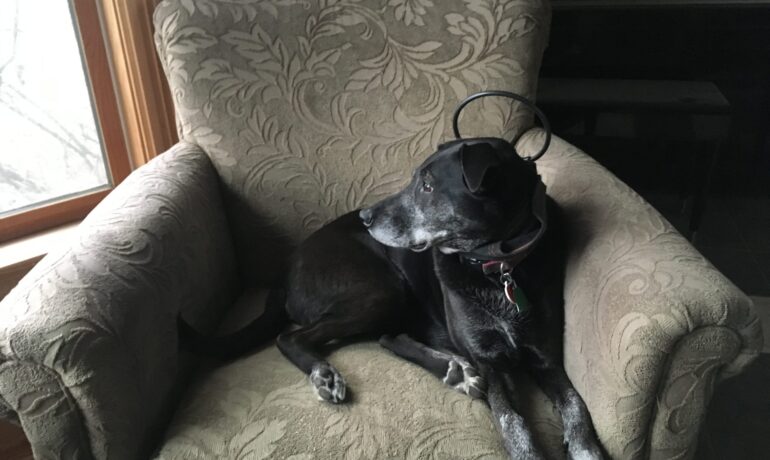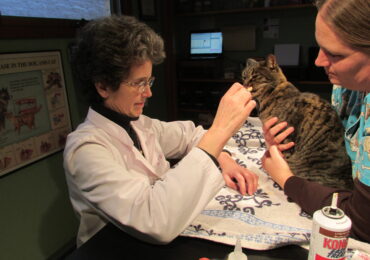 How the Calmer Canine tPEMF device improved my dog Bella’s reactivity
How the Calmer Canine tPEMF device improved my dog Bella’s reactivity
My dog Bella is an 11-year-old, mixed-breed dog. She was a rescue, who by 9 weeks of age was no longer able to easily socialize easily. Despite meds, supplements, training, low stress handling and reward-based training, she is reactive at windows. Her triggers are the sight of other dogs, squirrels, rabbits, and people walking past the house. Bella’s reactive behavior includes exploding from sleep, running, barking, and growling at the windows as she sees another dog walk past. A dragline is effective to redirect her if I can catch her in those first few seconds. I must be there to respond to her, so when I am not there, she is practicing this behavior frequently. No drug significantly reduces this behavior. Believe me, I have tried! Blocking the windows with paper reduced much of the reactivity but was unsightly, and I want to look out of my own windows.
At the Clinical Animal Behavior Conference in Las Vegas in October 2019, Judy Korman DVM presented a study by Margaret Gruen DVM, ACVB where the Calmer Canine device by Assisi Animal Health was used for separation anxiety cases ( http://www.assisianimalhealth.com/calmer-canine/). She presented the science behind the tPEMF ® technology, including video evidence pre and post-treatment from multiple cases. The results were very impressive showing dogs who were vocalizing and damaging property pre-treatment to resting quietly by week 6. Treatment consisted of two daily 15-minute loop sessions over a 6-week period. From Dr Gruen’s abstract, this protocol provided success in 100% of the dogs in the study, with 50% resolved of their separation anxiety (2). Behavior modification was included in the treatment protocol.
The technology of the tPEMF® is based upon the induction of an electromagnetic field around affected tissues. This pulse of energy affects the up regulation of nitrous oxide, the body’s own anti-inflammatory modulator (4). Inflammation in the brain is possible, especially as the brain ages or has had past injury.
As I sat through the lecture, I considered that Bella may benefit from this device since she is aging. Aging increases inflammation in the body and in the brain (3) so it would stand to reason that the tEPMF® technology should help reduce anxiety behaviors in aged dogs. Bella was increasing her barking frequency, and intensity as she grew older. She has been taking a joint supplement, Composure pro supplement, Purina Bright Minds diet mixed 50% with Calm diet by Royal Canin to reduce her reactivity and anxiety for a few years. Might this product help reduce her reactivity?
At the end of the lecture, Dr. Korman invited the attendees to consider a case and sign up for a free sample of the Calm Canine device. I was intrigued, and with an offer like this how could I not take advantage of the trial. I signed up and started Bella on the 6-week twice-daily treatment protocol.
Bella’s trial of the Calmer Canine
Before using the Calmer Canine, I removed the paper from all the windows for 5 days prior to starting the protocol to track Bella’s reactivity. I kept her on the diet, and supplements and calling her away using the dragline. I had added the paper visual blocking about 1 month earlier. The paper reduced her reactivity by 70%, but I did not want to live with paper on my windows forever. I created a chart to record her reactivity frequency and intensity. A level one was individual barks 1-2 seconds and can be called away. Level 2 was repeated barking with jumping up towards the window but will not come immediately when called. Level 3 was the immediate reaction at the window with continuous barking, jumping, and racing to another window with zero recall.
From Day 1 to Day 2 after removing the paper, Bella was back to her pre paper reactivity levels. Her level 3 reactivity triggers were the neighbor’s dogs, and squirrels in the yard. With a large walnut tree in our yard attracting lots of squirrels, and the neighbor dog visible on her stakeout chain twice daily. The 5 day “wash out” of the paper effect was tough. Calling her away, tethering her with rewards managed her behavior, but it was time-consuming and difficult to predict as the triggers were difficult to predict.
The product consists of a Velcro neck wrap with a chest wrap to hold the halo device in place. The dog can walk or lay comfortably using the body wraps as they receive treatment. I had Bella wear just the wraps at various 30 minutes to one -hour periods on day 5 to evaluate her acceptance of the wraps. She did not mind them at all. When she was laying in her bed relaxing, she only needed the neck wrap to attach the halo device.
On day 1 of the treatment protocol, I applied the halo when she was resting. She did not mind the halo, laying through treatment. I repeated this in the evening after her last walk. This was the typical treatment experience. I like self -timer that shuts the device down after 15 minutes. Again, one less thing for me to monitor. This was convenient as I could read or do other things with her in my sight just to be sure she was not pawing or scratching at it.
I continued to chart her reactivity score as the days progressed. By day 5 I could see her scores reduced in intensity and frequency. Yea!! Bella also started day boarding in preparation for a long boarding event. Typically, she would be anxious about new places, new people, and other dogs. Over this time, Bella was adjusting very quickly today boarding and interacting with the staff with far less anxiety than she would have previously shown. By week 4 of the protocol, Bella was boarded for 10 days. As it was Thanksgiving weekend, I did not bring the device. I decided to not add that work to the staff since at home Bella was not reacting to squirrels, the neighbor dog or the people walking by. She went from a score of 3 for these triggers to zero. For those 10 days, Bella ate, slept, and played with the staff. This is a huge improvement in anxiety reduction for my dog. When we picked her up, she was happy, had no bowel problems, and did not show any stress effects from boarding. When she was home, she did not relapse into any reactivity at the windows either.
I stopped the protocol to see how she would maintain her benefits. I did notice after 3 weeks; she was starting to react at the windows again. I restarted the device treatments once daily to see the results. After 1 week, she is back down to level 1 for people walking past, and the neighbor dog (her worst trigger) and zero for the other. I think Bella will need a little “brain balm” treatment from the device on some regular schedule to keep her reactivity down. Watch for blog updates as I figure from her response if it will be an alternate day, week, or what. It is easy to use, tolerated very well and my family feels good about using a non -drug device. I appreciate being able to see and experience how this product is used, learn more about the science behind the product, and the effect it has. Avoiding medication side effects and risks is also appreciated.
Personally, my biggest benefit is being able to see out my own windows, not worry about Bella injuring herself as she flies through the house, and always having to be on alert myself to managing her. I realize she is a single sample in this trial, and this is off label from the FDA approved use of the product. As an older dog. Bella is likely experiencing the effects of brain aging. Her resulting behavior improvement suggests the device is reducing age-related inflammation. Many of our older dogs are experiencing anxiety which may be linked with body inflammation, circulation, past brain injury and brain inflammation. There is now a long list of products to use to help reduce the signs of cognitive dysfunction, anxiety and brain aging. The Calmer Canine adds one more product to that list, improving the quality of life for our dogs, or pets and their owners.
Follow this link to find out about the Calmer Canine and purchase Calmer Canine link
Sally J Foote DVM, CABC-IAABC, LSHC-S copywrite 2020
- Overall, K. Dunham, F. Frank, D. Frequency of nonspecific clinical signs in dogs with separation anxiety, thunderstorm phobia, and noise phobia, alone or in combination
https://www.avma.org/sites/default/files/resources/javma_219_4_467.pdf
- Gruen, M. Griffith, E. Korman, J. Treatment of Canine Separation Anxiety Using a Pulsed Electromagnetic Field Device: A Pilot Study North Carolina State University College of Veterinary Medicine
Presented July 2019 at the IVBM Conference, Washington DC accessed Jan 2, 2020
- Head, E. Neurobiology of the Aging Dog. https://www.ncbi.nlm.nih.gov/pubmed/20845082 accessed Jan 2, 2020
- Sharma, JN. Al-Omran, A. Parvathy,SS. Role of Nitric Oxide in Inflammatory Diseases https://www.ncbi.nlm.nih.gov/pubmed/18236016 accessed Jan 2 , 2020


